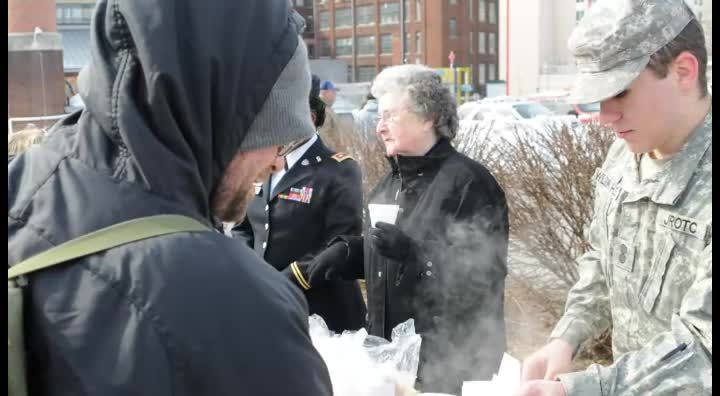 | ||
Homeless veterans are persons who have served in the armed forces who are homeless or living without access to secure and appropriate accommodation.
Contents
Background
Many of these veterans suffer from post traumatic stress disorder, an anxiety disorder that often occurs after extreme emotional trauma involving threat or injury. Causes of homelessness include:
Of 23,000 homeless veterans surveyed, 76 percent of them reported substance abuse, 61 percent reported physical health issues, and 55 percent reported mental health issues. All of these problems could have a direct correlation to their time in the service with physical injuries that occurred or post-traumatic stress disorder. By having these issues and living on the street, the chances of death can increase by 11 percent.
Demographics
Veteran homelessness is not a phenomenon only of the 21st century; as early as the Reconstruction Era, homeless veterans were among the general homeless population. In 1932, homeless veterans were part of the Bonus Army. In 1934, there were as many as a quarter million veterans living on the streets. During the Truman Administration, there were one hundred thousand homeless veterans in Chicago, and a quarter that population of homeless veterans in Washington, D.C.. In 1987, the number of homeless veterans was as high as three hundred thousand.
Estimates of the homeless population vary as these statistics are very difficult to obtain. In 2007, the first veterans of Operation Enduring Freedom - Afghanistan and Operation Iraqi Freedom, began to be documented in homeless shelters. By 2009 there were one hundred fifty four thousand homeless, with slightly less than half having served in South Vietnam. According to the VA in 2011, veterans made up 14% of homeless adult males, and 2% of homeless adult females, and both groups were over represented within the homeless population compared to the general population. The overall count in 2012 showed 62,619 homeless veterans in the United States of America. In January 2013, there were an estimated homeless veterans in the U.S., or 12% of the homeless population. Just under 8% are female. In July 2014, the largest population of homeless veterans lived in Los Angeles County, with there being over six thousand homeless veterans, part of the larger estimated fifty four thousand homeless within that area. In 2015, in a report issued by HUD, it counted over forty seven thousand homeless veterans nationwide, the majority of whom were White and male. In 2016, there were over thirty nine thousand homeless veterans nationwide.
Aid
Many programs and resources have been implemented across the United States in an effort to help homeless veterans. Among the prominent are:
HUD-VASH, a housing voucher program by the United States Department of Housing and Urban Development and Veterans Administration, gives out a certain number of Section 8 subsidized housing vouchers to eligible homeless and otherwise vulnerable U.S. armed forces veterans.
Historical
In 1887, the Sawtelle Veterans Home was constructed to care for disabled veterans, and housed more than a thousand homeless veterans. Other such Old soldiers' homes were built through out the United States, such as the one in New York. These homes became the predecessors of the Veteran Affairs' medical facilities.
Department of Veterans Affairs
On November 3, 2009, United States Secretary Eric K. Shinseki spoke at the National Summit on Homeless Veterans and announced his plan.
Along with President Barack Obama, Shinseki outlined a comprehensive five-year plan to strengthen the Department of Veterans Affairs and its efforts to end veteran homeless.. The goal was to end veteran homelessness by 2015, but because of budget constraints that has now been pushed to 2017. The plan focused on prevention of homelessness along with help for those living on the streets. The plan would expand mental health care and housing options for veterans, and would collaborate with:
In 2009, call centers were established in order to assist homeless veterans to gain assistance. As of December 2014, of the 79,500 veterans who contacted the call center, 27% were unable to speak to a counselor, and 47% of referrals lead to no support services provided to the homeless veteran.
In a study published in the American Journal of Addiction, it found that there was indeed a link between both trauma of mental disorders that came upon the veterans studied and the substance abuse they partook in.
Charity
In addition to government provided aid there are private charities that provide aid to homeless veterans as well. These include providing homeless veterans a vehicle to live in, building permanent housing for homeless veterans. Advocating for the rights of homeless veterans through policy implementation and recommendations. Through out the nation, multiple organizations and agencies from a given region, host "Stand Down" events where homeless veterans are provided items and services; the first of these was held in San Diego, organized by Vietnam veterans, in 1988.
